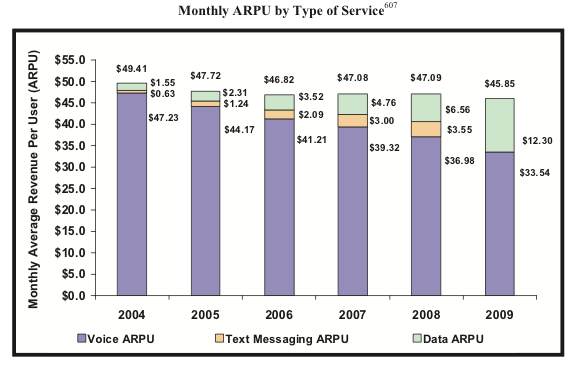The shift away from landlines continues, as 24.9 percent of all American adults now live in homes with wireless-only voice connections. Among younger adults aged 25 to 29, the numbers are twice as high; more than half have only a cell phone.
Don't feel too bad for the phone companies. The largest wireline companies, such as AT&T and Verizon, are linked with wireless units that have cashed in on the switch to cell phones and now rake in huge profits.
Running the numbers
The FCC's 15th wireless communications report has all the numbers. Like the last report, this one refuses to reach any conclusion about "competition" in the industry (though it does show a "highly concentrated" industry under standard antitrust metrics). But if you want to know how many Americans have a cell phone and how much they pay for it, the report is a gold mine.
Americans certainly love their cell phones. Of the 308 million people resident in the US, 274 million subscribed to wireless service at the end of 2009—and 55.8 million people subscribed to a mobile Internet service plan.
The big providers—AT&T and Verizon Wireless, which dominate the market—have cashed in, earning their highest profit margins in a decade and blowing away most of their smaller competitors when it comes to profitability. The chart below shows wireless carrier profits before interest, taxes, depreciation, and amortization are factored in (a standard metric known as EBITDA).

In late 2010, AT&T and Verizon accounted for more than 80 percent of EBITDA in the wireless industry and were showing EBITDA margins of 40 percent.
Still, as AT&T likes to remind regulators when flogging its $39 billion proposed buyout of T-Mobile USA, mobile prices for consumers have declined thanks to competition. That's true, but the FCC data shows just how limited such price declines are. In 2004, the industry's average monthly revenue per user (ARPU) was $49.41. In 2009, it had fallen only to $45.85, with increased data revenues offsetting the declining cost of voice service.

Many Europeans pay less per month (Germans pay only an average of $22.08 each month for service) but they also receive (and use) fewer voice minutes. If you like to talk by the hour, America's your destination; if not, you'll probably pay for many minutes you don't need.
Americans, longtime laggards when it comes to texting (in part because voice minutes were so abundant), are racing to catch up. The average cell user sent 488 text messages each month in 2009—up from a mere 69 three years before. My thumbs hurt just thinking about it.
Listing image by http://www.flickr.com/people/compujeramey/
reader comments
104